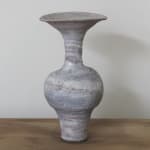Lucie Rie (1902−1995)
Vase with Spiral Pattern
Sealed sign “LR” on foot
Double boxed
W14.5 x H26.8 cm
Further images
Gently winding spiral pattern and soft colors; variegated textures of the surface created by fine froths; vessel shape whose mouth resembles to that of a trumpet... This vase represents Lucie Rie’s distinctive crafts. The froth glaze technique is also called “volcanic glaze,” which is Rie’s original glazing technique largely used in the 1970s and 80s. The technique involves introducing different colorants and active minerals to a glaze, so that on top of the stoneware ground a dramatic range of surface effects are achieved. The flowing shape as well as its spiral, gradating color changes are the major characteristics of the present work, which contrast to her works of clear color compositions achieved through applying pink or blue glazes over manganese glazes. Rie’s diverse aesthetics is well reflected. A ca. 1979 flower vase of a similar spiral pattern made with the froth glaze technique is widely known, for reproduction of its image appeared on the design of a British stamp.
The thin and tall foot of this work is also recognized as Rie’s distinctive style, which is said to have been influenced by the advice of Bernard Leach, the pioneer of the British studio ceramics. Rie also shared Leach’s persistence of the wheel throwing craft. It is this frankness and her thorough exploration of glazing methods that gave her works a universal aesthetics, which transcends the East and West border.
Lucie Rie (potter; 1902–1995)
Vienna-born potter. Learnt ceramic making under Michael Powolny at the Kunstgewerbeschule, Established a modernist, metropolitan style of vivid colors and sophisticated forms after fleeing to London. Recipient of the Dame Commander of the Order of the British Empire (DBE).
The thin and tall foot of this work is also recognized as Rie’s distinctive style, which is said to have been influenced by the advice of Bernard Leach, the pioneer of the British studio ceramics. Rie also shared Leach’s persistence of the wheel throwing craft. It is this frankness and her thorough exploration of glazing methods that gave her works a universal aesthetics, which transcends the East and West border.
Lucie Rie (potter; 1902–1995)
Vienna-born potter. Learnt ceramic making under Michael Powolny at the Kunstgewerbeschule, Established a modernist, metropolitan style of vivid colors and sophisticated forms after fleeing to London. Recipient of the Dame Commander of the Order of the British Empire (DBE).





